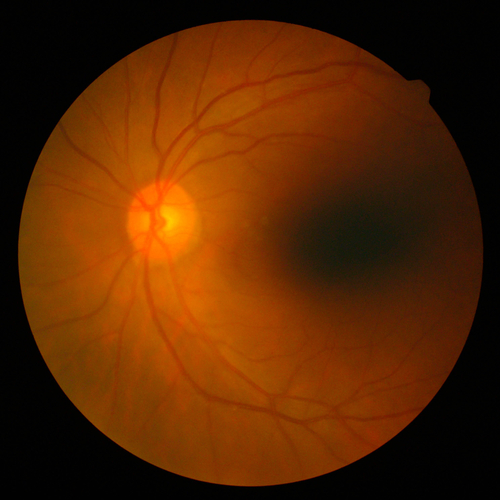 What is a retinal detachment?
What is a retinal detachment?
A retinal detachment is occurs when the retina separates from the back wall of the eye. This typically happens when liquefied vitreous fluid passes through a small tear in the retina and collects behind the retina. This collection of fluid causes a lifting action and markedly disturbs the vision. Frequently, detachments begin with loss of peripheral vision and patients may notice a dark shadow, or a veil, coming from one side, above or below. Left untreated, in most cases, after a retinal detachment starts, the entire retina will eventually detach and all useful vision in that eye will be lost.
Who gets retinal detachments?
Some people are at increased risk of developing retinal detachments. The high risk group includes those with a high degree of nearsightedness, a family history of retinal detachment, or those who have previously experienced a retinal detachment. Patients that have had cataract surgery also experience about a 1-2 % chance of developing a retinal detachment.
What is the treatment for retinal detachment?
The retinal surgeon will decide the most effective treatment for a retinal detachment or tear. If a retinal detachment or tear is small, it may be repaired using laser surgery, cryoptherapy (freezing an area), or a combination of the two. If a detachment becomes too large for the laser treatment or cryotherapy alone, surgery is normally necessary to reattach the retina. Without surgery, vision will almost always be completely lost. There are three types of surgery for retinal detachment: 1) scleral buckling surgery, 2) pneumatic retinopexy, and 3) vitrectomy.
Scleral buckling involves pushing the sclera (outside wall of the eye) against the retina using a silicone band while sealing the retinal tear with cryotherapy. Pneumatic retinopexy involves the intraocular injection of an inert gas bubble to press on the retina and seal the retinal break. Vitrectomy is typically reserved for more severe and complicated retinal detachments and consists of the removal of the liquid, gelatinous mass that fills the rear two-thirds of the eye between the lens and the retina. The vitreous is replaced with either clear fluid or a gas that completely fills the eye. Each type of surgery has varying success rates.
What are floaters and flashers?
As people age, the vitreous or jelly part of the eye tends to liquefy. This is a normal aging process. As the vitreous liquefies, it also tends to shrink, which is also normal. Shrinkage can then cause some traction or pulling of the vitreous or jelly on the retina. When this happens, most of the time the vitreous will separate from the retina and optic nerve cleanly. This separation is called a posterior vitreous detachment, or PVD. With age, PVDs happen in almost every eye but only infrequently cause a treatable problem. As the vitreous ages and liquefies, it also changes consistency and becomes stringy and forms strands. These strands float in the vitreous and cast shadows on the retina. They are seen by the patient as spots, cobwebs, spiders, or a series of irregular fine lines in the vision. Since these particles appear to move or “float” in the field of vision, they are referred to as floaters.
Flashes of light, often referred to as “flashers”, is also a symptom of a PVD. These occur as a result of the pulling effect of the vitreous separating from the retina. Patients see this as brief flashes of light or large spots in their vision. While this can be alarming, in most PVDs the condition will eventually correct itself and the flashes do not pose any threats to the vision. However, if the PVD pulls a tiny bit of the retina with it, a hole or tear in the retina can occur. A hole or tear in the retina, in almost all cases, needs to be fixed soon because the fluid vitreous can go through the hole or tear and get behind the retina and progress to a retinal detachment.
If there are symptoms associated with a vitreous separation, we need to see you. If you have dozens of floaters, which would be black dots like ants, gnats, or bees flying around in your eye, or if your have one or two new large floaters, flashes of light, cobwebs, or a curtain, you need to be seen. If we determine that you only have a vitreous separation (PVD) without a hole or tear in your retina, then no treatment is necessary. You would be instructed to refrain from heavy lifting or strenuous activities for 2 weeks after the vitreous separation occurred. However, if we find a hole or tear in your retina with these symptoms, then either laser surgery, or cryotherapy will usually take care of it. If it goes on to become a retinal detachment, then you may require major retinal detachment surgery.





